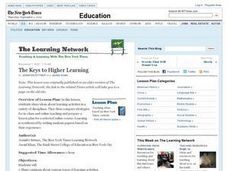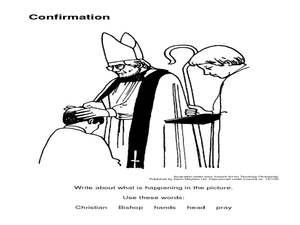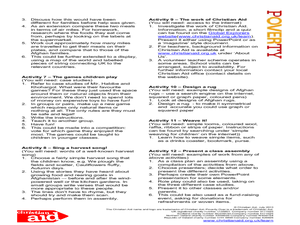Curated OER
Comparing the Ancient and Modern Olympics: A Venn Diagram
Students compare and contrast today's Olympic Games to those held in ancient Greece. They read newspapers, conduct Internet research, watch TV coverage of current Olympic Games and organize their findings on a Venn diagram.
Curated OER
Gone With The Wind
Students review the different types of natural disasters. As a class, they examine how people and communities deal with weather disasters. They compare and contrast how two communities respond to a tornado or hurricane. They present...
Curated OER
European Union Map Quest
Sixth graders identify countries of the European Union. They locate countries of Europe on a map and pair with a student to complete a blank map of Europe. They label each country and complete worksheets for the European Union. They...
Curated OER
Analyzing Advertising
Learners critically examine advertising. They investigate how to become wiser consumers. They explore the topic of advertising more deeply by using the reports called "Web of Deception" and "Selling America's Kids: Commercial Pressures...
National First Ladies' Library
Who Invented Crayons?
Pupils use a specified website to study the history of Crayola crayons. In groups, they discover who invented the colors, their cost, and who thought of the name. Young scholars create a timeline of Crayola colors and choose one project...
Curated OER
The Keys To Higher Learning
Students discuss the validity of using the internet for learning. They compare and contrast the various strategies for learning when done online and in class. Students prepare a lesson plan for an online class and write a paper...
Curated OER
We Are Colony! Settlement Design
Young scholars explore government systems. In this colonial America instructional activity, students consider colonial settlement needs as they design settlements that can sustain themselves and meet the needs of colonists.
Curated OER
Sacred Giving- Why?
Middle schoolers define the Jewish concept of tzedakah. In this religious lesson, students read portions of the Torah and discuss the meaning of tzedakah. Middle schoolers visit a Jewish Community Center.
Curated OER
Presidents
Students identify the qualities needed to become President of the United States. Using the internet, they discover the differences in character of past presidents and draw conclusions about their time in office. They relate a piece of...
Curated OER
Winter of Red Snow
Sixth graders read and respond to historically significant works of literature that reflect and enhance their studies of history and social science. They engage in group projects, such as replicating Valley Forge.
Curated OER
Class Memorial
Student commemorate the victims of the Holocaust. In this Holocaust lesson, learners plan and implement a memorial service for Holocaust victims as the culmination of a Holocaust unit.
Curated OER
Subway Drawings
Pupils create oil pastel paintings where they cover the whole paper with oil pastels and outline and smear with black. In this oil pastels lesson plan, students first study the Subway Drawings done by Keith Haring.
Curated OER
Old Photographs: Windows to the Past
Students examine several types of old photographs and compare them to photography today. Students search for historical photographs and draw conclusions about the time period from the subject matter. Students explain how a camera...
Curated OER
Going...going...gone? Tropical Rainforests-How They Work, What They Do for Us, What's Being Done to Them...
Sixth graders explore the Tropical Rainforest and come to understand what it is and how it affects the ecosystem. In this rainforests lesson, 6th graders write about the Tropical Rainforest, imagine they are in the Tropical Rainforest,...
Curated OER
A GREAT SPORT
Students explore how diverse groups and individuals have contributed to the cultural development of Canada, and then produce two-dimensional works of art.
Curated OER
MAISA and the REMC Association of Michigan
Learners complete online research to study geography's impact on weather. In this geography and weather lesson, students research weather in their city for ten days using an online website. Learners bookmark the site, enter data into a...
Curated OER
Exploring the Hudson in 1609
While this lesson focuses on a study of the Hudson River, it could be used as a template for a discussion of map skills, converting measurements, and plotting a route. The lesson includes vocabulary and other resources to make it a...
Curated OER
Hands-On Outlining
In order to write an effective outline, children must be able to identify main ideas and supporting details, which is the aim of this fun and kinesthetic activity. The class works on the floor to organize sentence strips prepared by the...
Curated OER
Bill Irwin: All in a Day's Work
Pupils research and examine the various roles needed to put on a major drama production. Using this information, they role play one of these different responsibilities. As a class, they perform a play of their choosing and receive...
Curated OER
Lessons from History
Students review key vocabulary in history and review a specific website. They write a paragraph summarizing an event they read about on this website. They analyze the importance of studying and learning from history.
Curated OER
Confirmation
In this Confirmation worksheet, students color the picture of a Confirmation and write about it using words from a word bank. Students use 5 words.
Curated OER
Learning To Look
Pupils examine Jacques-Louis David's Telemachus and Eucharis and Dorothea Lange's photograph of a migrant mother and consider how artists communicate ideas across time. They look closely at, and think creatively about artworks.
Curated OER
Harvest
Pupils research the harvest period in Afghanistan. In this harvest lesson plan, students learn about Afghanistan's weather, games children play, rug designing, harvest songs, and more about the harvest time.
Curated OER
Exploring Nonprofits
Students research nonprofit organizations. In this philanthropy lesson, students use the Yellow Pages to identify nonprofit organizations and graph the organizations according to category.























